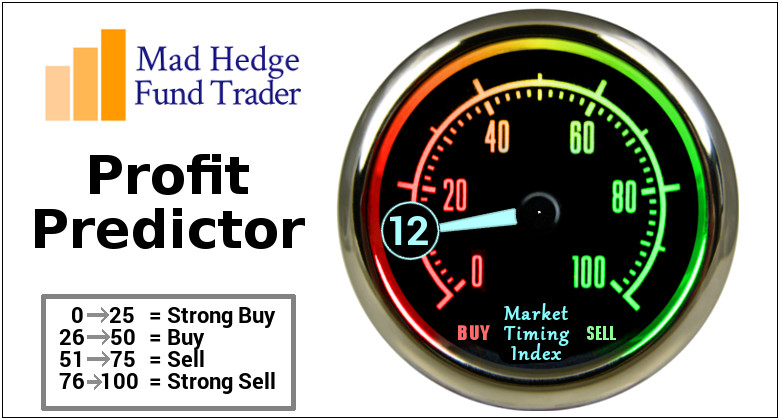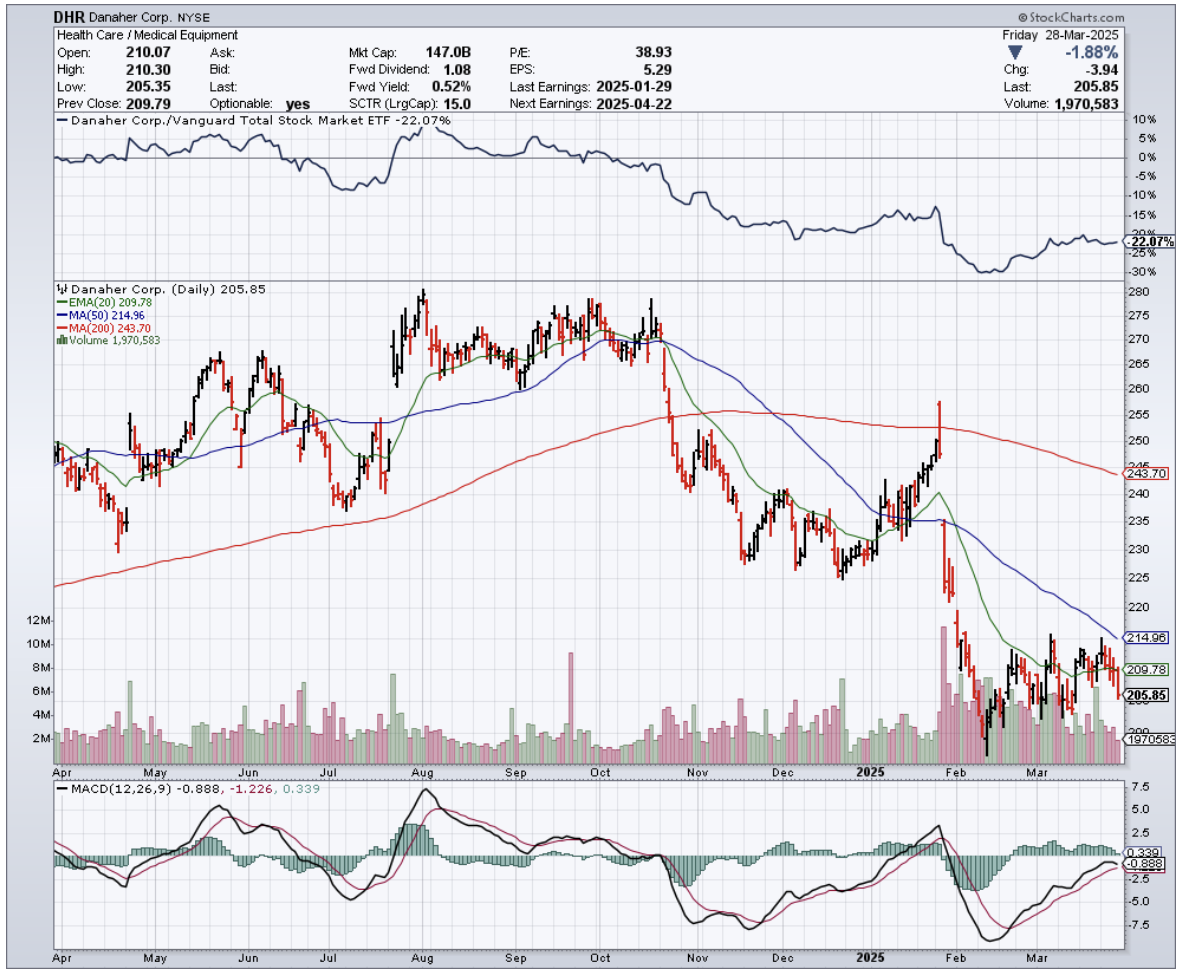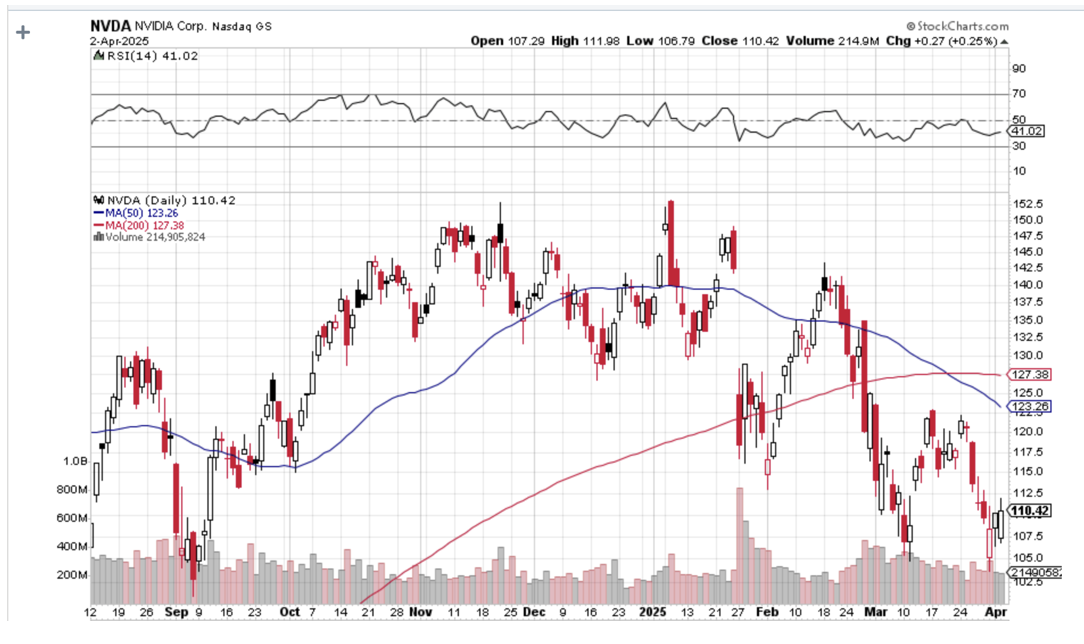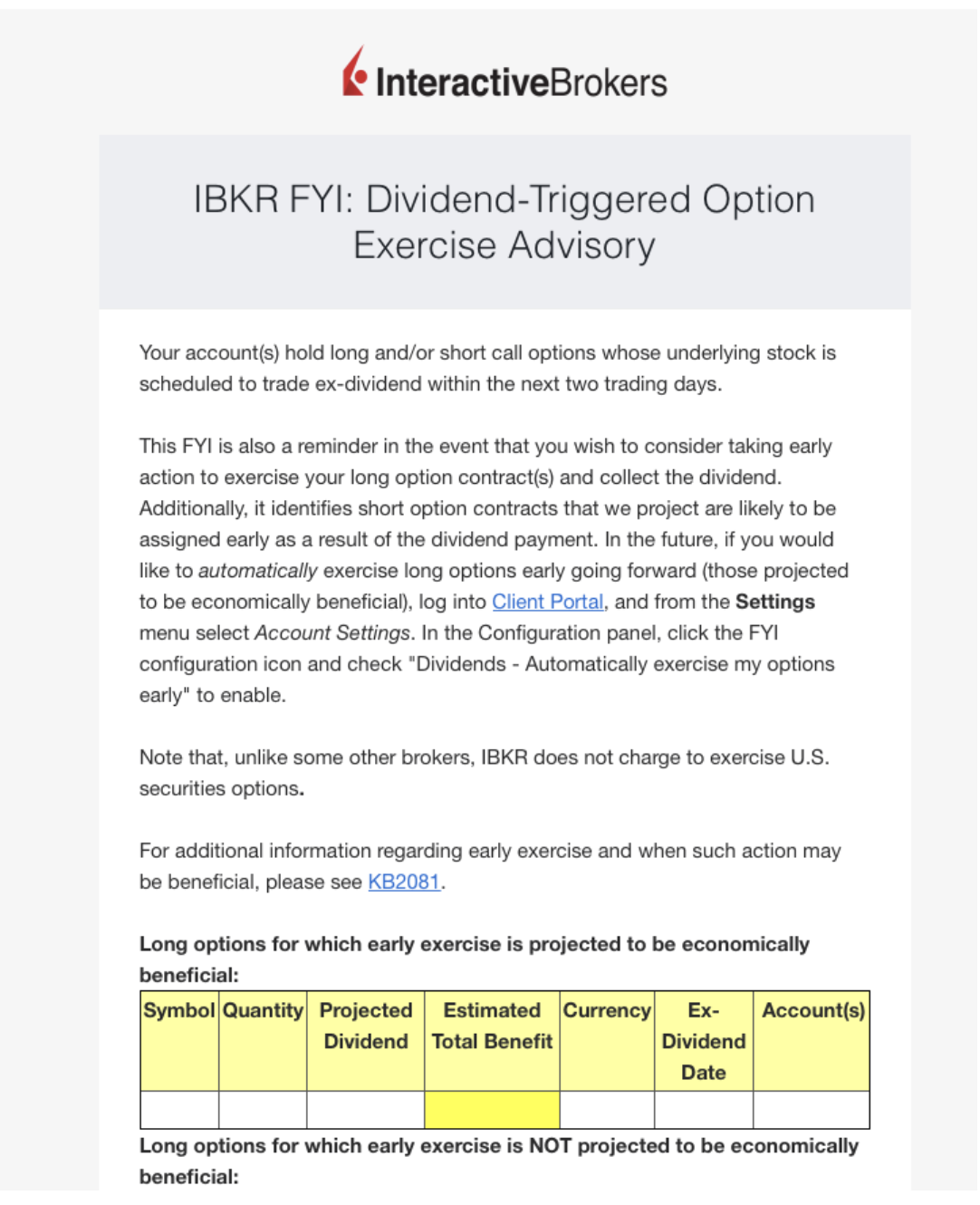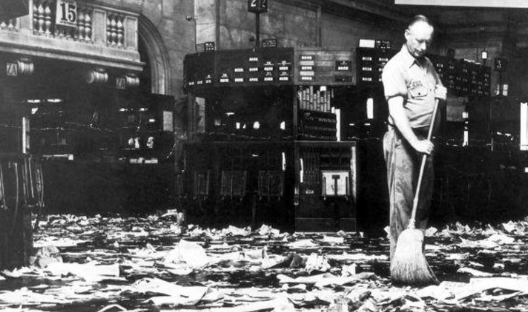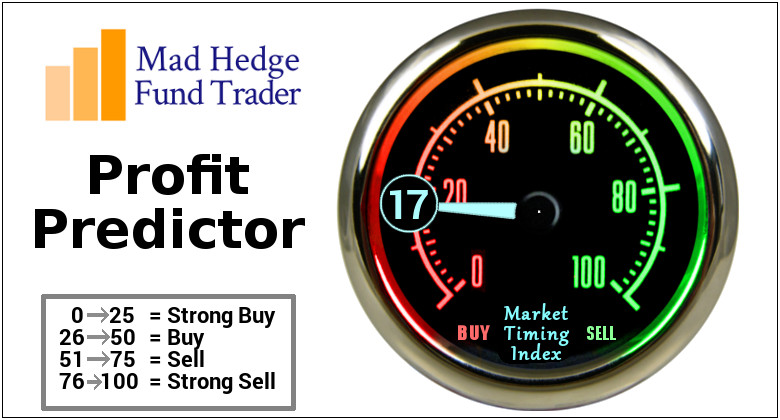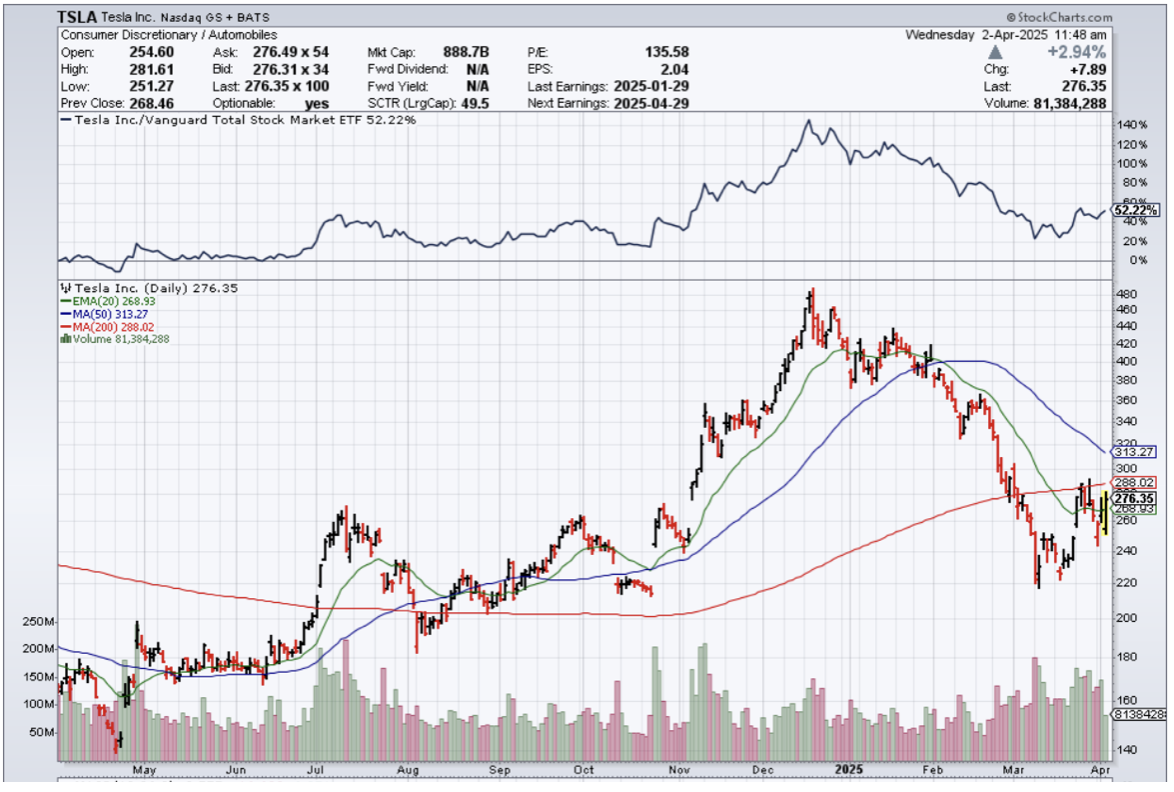When John identifies a strategic exit point, he will send you an alert with specific trade information as to what security to sell, when to sell it, and at what price. Most often, it will be to TAKE PROFITS, but on rare occasions, it will be to exercise a STOP LOSS at a predetermined price to adhere to strict risk management discipline. Read more
When John identifies a strategic exit point, he will send you an alert with specific trade information as to what security to sell, when to sell it, and at what price. Most often, it will be to TAKE PROFITS, but on rare occasions, it will be to exercise a STOP LOSS at a predetermined price to adhere to strict risk management discipline. Read more
Mad Hedge Biotech and Healthcare Letter
April 3, 2025
Fiat Lux
Featured Trade:
(MIND THE GAP)
(DHR)
Last Thursday, I found myself trapped in an elevator with the former head of R&D at one of Boston's leading life sciences companies – a guy I've known since my Tokyo days in the late '70s.
After we established that neither of us knew how to hack the elevator controls (disappointing, since he has three engineering degrees from MIT), he leaned in and whispered, "You know what's crazy? Everyone's obsessing over AI stocks while Danaher is sitting there at nearly a 30% discount to historical valuations."
The elevator started moving before I could press him for details, but his comment sent me down a research rabbit hole that kept me up until 3 AM.
My old friend wasn't wrong. Danaher (DHR) has quietly become one of the most compelling value opportunities in the life sciences sector.
While lesser investors are chasing the latest semiconductor hype, DHR is trading at 26.9x forward earnings – a substantial discount to its five-year average multiple of 30.2x – all while positioning itself for what looks like a significant rebound in 2026.
I've been tracking Danaher since their earliest acquisition days in the late 1990s, and their current setup reminds me of late 2018 when they were preparing to acquire GE's biopharma business.
Back then, short-term concerns created a buying opportunity that delivered a 150% return over the next three years.
Today's discount stems from China's Volume-Based Procurement initiative and lower respiratory testing revenues at Cepheid – both temporary headwinds that mask the company's extraordinary long-term potential.
What most market participants are missing is that Danaher's core growth engine – its Biotechnology segment – is showing undeniable signs of life.
Their latest quarterly orders grew over 30% year-over-year, marking the sixth consecutive quarter of high single-digit sequential growth.
After two years of inventory destocking that felt like watching paint dry (if the paint cost $10,000 per gallon), the bioprocessing business has returned to positive growth territory.
The company's Life Sciences segment also turned positive last quarter, benefiting from Chinese stimulus funding that took longer than expected to materialize – sort of like waiting for your teenager to clean their room, but with billions of dollars at stake.
While Q1 will face tough year-over-year comparisons due to a large energy project last year, management expects growth to accelerate through 2025, culminating in a major Pall customer project in Q4.
Now, Danaher does face legitimate near-term challenges. Their Diagnostics segment is battling headwinds from China's VBP initiative, which accelerated unexpectedly in late 2024.
Management now estimates a $150 million impact for 2025 on top of the $50 million already absorbed in 2024. They've also guided for respiratory testing revenue to drop from $1.95 billion to $1.7 billion this year.
But here's where things get interesting. The flu season is turning out to be significantly more severe than anticipated – one of the worst in 15 years according to CDC data I reviewed yesterday.
This suggests management's respiratory testing guidance could prove conservative. Meanwhile, their non-respiratory portfolio is growing at mid-teens rates, with their women's health multiplex vaginitis panel increasing by over 20%.
What truly separates sophisticated investors from the herd is understanding that Danaher's management team rarely sits idle during challenging periods.
True to form, they've implemented a cost reduction program targeting at least $150 million in annual savings, focused specifically on offsetting the VBP impact in China and the Diagnostics segment.
This isn't their first rodeo with margin pressure – they've maintained their remarkable 30-year track record of operational improvement through far worse conditions.
The long-term growth thesis remains rock solid. The bioprocessing business is perfectly positioned to capitalize on biologics and biosimilar adoption as major patents expire in coming years.
According to management, there are approximately 600 FDA-approved biologics today with over 20,000 in the pipeline. Their Cytiva business supports over 90% of global monoclonal antibody manufacturing volumes – a stunning competitive position in one of healthcare's fastest-growing segments.
For perspective, it's like owning the only company that makes drill bits during a massive oil boom.
I've analyzed Danaher's forward P/E ratio across multiple market cycles, and the current valuation represents a compelling entry point for patient investors.
At 24x 2026 earnings estimates, the stock is pricing in virtually zero multiple expansion despite the company's historical premium to the market. The consensus expects EPS to grow from $7.66 in 2025 to $8.58 in 2026 – a 12% increase that looks conservative given the margin expansion potential as revenues recover.
I've started building a position at these levels, with plans to add on any further weakness. While timing the absolute bottom is a fool's errand (believe me, I've tried and have the investment scars to prove it), the current valuation provides a meaningful margin of safety.
I'm targeting a return to at least 28-30x forward earnings over the next 18-24 months as growth visibility improves, which would translate to approximately 25-30% upside from current levels.
As a veteran of both market crashes and faulty elevators, I've learned one crucial lesson: the key difference between being stuck in an elevator and stuck in an undervalued stock is that only one of them lets you press the “up” button when you've reached the bottom.
And if Danaher delivers as expected, I might just start hanging out in more broken elevators looking for my next investment idea.
Global Market Comments
April 3, 2025
Fiat Lux
Featured Trade:
(A NOTE ON OPTIONS ASSIGNED OR CALLED AWAY)
(NVDA), (COST), (TSLA)
I just received an excited text message from an excited Concierge client. His long position in the (NVDA) April 17 2025 $90-$95 vertical bull call debit spread had just been called away. That meant he would receive the maximum profit a full 10 trading days before the April 17 option expiration. Whoever called away the option ended up eating all of the remaining premium.
With the heightened volatility today, I am seeing an increasing number of options positions assigned or called away.
I know all of this may sound confusing at first. But once you get the hang of it, this is the greatest way to make money since sliced bread.
I still have three positions left in my model trading portfolio that are deep in-the-money, and about to expire in 10 trading days on the April 17 options expiration day. Those are the
(NVDA) 4/$90-$95 call spread 10.00%
(COST) 4/$840-$850 call spread 10.00%
(TSLA) 4/$160/$170 put spread 10.00%
That opens up a set of risks unique to these positions.
I call it the “Screw up risk.”
As long as the markets maintain current levels, this position will expire at its maximum profit value.
There is a heightened probability that your short position in the options may get called away.
Although the return for those calling away your options is very small, this is how to handle these events.
If exercised, brokers are required by law to email you immediately.
If it happens, there is only one thing to do: fall down on your knees and thank your lucky stars. You have just made the maximum possible profit for your position instantly.
Most of you have short-option positions, although you may not realize it. For when you buy an in-the-money vertical option spread, it contains two elements: a long option and a short option.
The short options can get “assigned,” or “called away” at any time, as it is owned by a third party, the one you initially sold the put option to when you initiated the position.
You have to be careful here because the inexperienced can blow their newfound windfall if they take the wrong action, so here’s how to handle it correctly.
Let’s say you get an email from your broker telling you that your call options have been assigned away.
I’ll use the example of the Berkshire Hathaway (BRK/B) from last August $405-$415 in-the-money vertical Bull Call spread since so many of you had these.
For what the broker had done in effect is allow you to get out of your call spread position at the maximum profit point 11 days before the August 16 expiration date.
In other words, what you bought for $8.70 on July 12 is now worth $10.00, giving you a near-instant profit of $1,300 or 14.94% in only 11 trading days.
All you have to do is call your broker and instruct them to “exercise your long position in your (BRK/B) August 16 $405 calls to close out your short position in the (BRK/B) August $410 calls.”
You must do this in person. Brokers are not allowed to exercise options automatically, on their own, without your expressed permission.
You also must do this the same day that you receive the exercise notice.
This is a perfectly hedged position. The name, the ticker symbol, the number of shares, and the number of contracts are all identical, so you have no exposure at all.
Call options are a right to buy shares at a fixed price before a fixed date, and one option contract is exercisable into 100 shares.
Short positions usually only get called away for dividend-paying stocks or interest-paying ETFs like the (BRK/B). There are strategies out there that try to capture dividends the day before they are payable. Exercising an option is one way to do that.
Weird stuff like this happens in the run-up to options expirations like we have coming.
A call owner may need to sell a long (BRK/B) position after the close, and exercising his long (BRK/B) call, which you are short, is the only way to execute it.
Adequate shares may not be available in the market, or maybe a limit order didn’t get done by the market close.
There are thousands of algorithms out there that may arrive at some twisted logic that the puts need to be exercised.
Many require a rebalancing of hedges at the close every day which can be achieved through option exercises.
And yes, options even get exercised by accident. There are still a few humans left in this market to blow it by writing shoddy algorithms.
And here’s another possible outcome in this process.
Your broker will call you to notify you of an option called away, and then give you the wrong advice on what to do about it.
There is a further annoying complication that leads to a lot of confusion. Lately, brokers have resorted to sending you warnings that exercises MIGHT happen to help mitigate their own legal liability.
They do this even when such an exercise has zero probability of happening, such as with a short call option in a LEAPS that has a year or more left until expiration. Just ignore these, or call your broker and ask them to explain.
This generates tons of commissions for the broker but is a terrible thing for the trader to do from a risk point of view, such as generating a loss by the time everything is closed and netted out.
There may not even be an evil motive behind the bad advice. Brokers are not investing a lot in training staff these days. In fact, I think I’m the last one they really did train.
Avarice could have been an explanation here but I think stupidity and poor training and low wages are much more likely.
Brokers have so many ways to steal money legally that they don’t need to resort to the illegal kind.
This exercise process is now fully automated at most brokers but it never hurts to follow up with a phone call if you get an exercise notice. Mistakes do happen.
Some may also send you a link to a video of what to do about all this.
If any of you are the slightest bit worried or confused by all of this, come out of your position RIGHT NOW at a small profit! You should never be worried or confused about any position tying up YOUR money.
Professionals do these things all day long and exercises become second nature, just another cost of doing business.
If you do this long enough, eventually you get hit. I bet you don’t.
Calling All Options!
“Stock prices have reached what looks like a permanently high plateau,” said economist Irving Fisher….just before the 1929 stock market crash.
The reverberations through Wall Street were palpable as the first quarter of 2025 drew to a close. The Nasdaq 100, the bellwether index for the technology sector, had just concluded its most turbulent period in nearly three years, a dramatic downturn fueled by a confluence of economic anxieties and, most notably, escalating fears of an artificial intelligence (AI) bubble.
The sharp correction, which saw the index shed a significant percentage of its value, served as a stark reminder of the market's inherent volatility, even in the face of seemingly unstoppable technological advancement. The prior year's exuberant rally, driven by the promise of AI's transformative potential, had given way to a sobering reassessment of valuations and the sustainability of the AI-driven surge.
A Perfect Storm of Uncertainty
Several factors contributed to the Nasdaq 100's precipitous decline. Concerns over rising interest rates, persistent inflationary pressures, and geopolitical instability created a climate of widespread unease. However, it was the growing apprehension surrounding the AI sector that proved to be the most decisive catalyst.
- AI Bubble Fears:
- The rapid ascent of AI-related stocks in 2024 had drawn comparisons to the dot-com bubble of the late 1990s. Investors began to question whether the astronomical valuations of many AI companies were justified by their actual earnings and long-term prospects.
- Concerns mounted regarding the potential for overinvestment in AI infrastructure, particularly data centers, and the possibility of diminishing returns.
- The sheer velocity of AI development, while promising, also introduced uncertainty about the long-term viability of specific technologies and business models.
- Economic Headwinds:
- Persistent inflationary pressures forced central banks to maintain a hawkish stance, leading to higher interest rates that weighed heavily on growth stocks.
- Concerns over a potential economic recession added to investor anxieties, prompting a flight to safer assets.
- Geopolitical tensions created further market instability.
- Data Center Spending Concerns:
- A large portion of the recent tech sector boom was based on the massive building of data centers, to power the AI revolution. Questions began to arise regarding the long term usage rates of these massively expensive builds.
The Impact on Tech Giants
The downturn had a particularly pronounced impact on some of the largest and most influential companies in the Nasdaq 100. Tech titans that had led the AI-fueled rally experienced substantial declines in their share prices.
- Companies that had been at the forefront of AI chip development and data center infrastructure saw their valuations plummet as investors reassessed the sustainability of their growth trajectories.
- Even companies with diversified revenue streams were not immune to the market's overall pessimism, as the AI bubble fears cast a shadow over the entire technology sector.
- Specific companies that had experienced extremely high growth, saw the largest drops in stock prices.
Market Analysis and Investor Sentiment
Analysts pointed to a shift in investor sentiment, from unbridled optimism to cautious skepticism. The prevailing narrative had transitioned from "AI can do anything" to "at what cost, and when will we see returns?"
- The market's correction was seen by some as a healthy adjustment, a necessary recalibration after a period of excessive exuberance.
- Others expressed concern that the downturn could signal the beginning of a more prolonged bear market, driven by fundamental economic weaknesses and a loss of confidence in the technology sector.
- Financial news outlets were filled with reports of investors pulling money from tech focused funds, and placing those funds into more stable investments.
Looking Ahead: The Future of AI and the Nasdaq 100
The long-term implications of the Nasdaq 100's downturn remain uncertain. While the AI sector's potential remains undeniable, the market's recent correction underscores the importance of realistic valuations and sustainable growth.
- The future of AI will likely depend on the ability of companies to demonstrate tangible returns on their investments and to navigate the evolving regulatory landscape.
- The Nasdaq 100's performance in the coming quarters will be closely watched as investors seek clarity on the AI sector's long-term prospects.
- There is a growing feeling that the AI sector will continue to grow, but at a more sustainable pace.
- Many analysts are now saying that careful company vetting will be more important than ever.
Key Takeaways
- The Nasdaq 100 experienced its worst quarter in years, driven by AI bubble fears and broader economic anxieties.
- Tech giants that had led the AI-fueled rally saw significant declines in their share prices.
- Investor sentiment shifted from unbridled optimism to cautious skepticism.
- The future of AI and the Nasdaq 100 hinges on the ability of companies to deliver tangible returns and navigate evolving market conditions.
- Market analysts are now emphasizing the importance of sustainable growth, and realistic valuations.
- The effects of this market correction are expected to be felt for many months to come.
The recent market correction serves as a potent reminder of the inherent volatility of financial markets and the importance of disciplined investing. As the AI sector continues to evolve, investors will need to carefully weigh the potential rewards against the inherent risks.
Mad Hedge Technology Letter
April 2, 2025
Fiat Lux
Featured Trade:
(THE TRUTH ABOUT TESLA THE BUSINESS MODEL)
(TSLA), (DOGE)
It is becoming more than obvious that Elon Musk’s venture into politics is hurting his business as Tesla dishes us some bad results from the latest quarter.
The amount of global deliveries failed to meet the mark and demand has been sapped for a variety of reasons.
Before getting more into it, I must say that European and American EV makers face an existential test against the Chinese and this challenge isn’t a decade or 2 off – it is right here and right now.
China has used its technological prowess to quickly rise up through the value-added supply chain and they now make a smartphone almost as high quality as an iPhone but for just a fraction of the price.
If we extrapolate this concept further out in terms of directional trajectory, the Chinese will most likely reproduce a similar outcome in aviation, humanoid robots, AI, semiconductor chips, automation and every leading tech sub-sector.
Musk certainly knows this which is why he is pivoting to robo-taxis and humanoid projects that are making headway, but not ready for commercial use.
The pie shrinking and the Chinese grabbing larger pieces of it is why Tesla only reported a paltry 336,681 deliveries versus 390,342 estimated.
This marks the worst quarter for deliveries since the second quarter of 2022.
The refreshed Model Y went on sale globally in March, which could be a reason for depressed demand for its top-selling vehicle.
Tesla sales have been stalling across most of its global territories. Earlier this week, Tesla registration data in key European regions fell in March, another sign that sales are continuing to slide in one of its key markets as Tesla's brand has also taken a backseat to Elon Musk’s political foray.
In France, only 3,157 Tesla EVs were registered, down 36.8% from a year ago. Norway saw only 2,211 registrations, down 63.9%. Sweden’s tally of 911 was only down 1%.
Tesla’s registrations are a close proxy for sales, which the company only reports quarterly and does not break out by region.
Another worrying trend that I must bring up is the rapid increase in political violence against Tesla products which is quickly muddying the prestigious brand.
Consumers simply won’t feel safe to buy or drive around in a Tesla if there is a good chance it will get blown up or vandalized.
It would be a good idea for Tesla if Musk clarified his role in running the Department of Government Efficiency (DOGE) and balancing his duties with Tesla.
Even if he does clarify his position, then it could all be for naught with politics quickly dissolving into a zero-sum game in almost every G20 country.
If we step back and look at the broader picture, it appears as if Tesla and Musk have run up to the extreme limit of his personal and political success in the short-term.
Any further meaningful progress will mean Musk “breaks the wall” and radically pivots into something new that will be the catalyst for another leg up in Tesla shares. He will also need federal government cooperation to do this which he didn’t have in the last administration.
Unfortunately, that transition process could become acutely painful for Tesla the business model in the short-term, and any trader looking for a quick mini-dip buy should avoid Tesla for now.
For long-term investors, this is a stock that hasn’t factored in robo-taxi or humanoid technology, and if anyone gets to deploy these two technologies, it will be Tesla and nobody else.
The risks to innovation can be sometimes existential while sting in the short-term, and Musk is finding that out in all its glory.
In the short-term, put on your seatbelt for heightened volatility, and long-term, buy and hold Tesla.
Legal Disclaimer
There is a very high degree of risk involved in trading. Past results are not indicative of future returns. MadHedgeFundTrader.com and all individuals affiliated with this site assume no responsibilities for your trading and investment results. The indicators, strategies, columns, articles and all other features are for educational purposes only and should not be construed as investment advice. Information for futures trading observations are obtained from sources believed to be reliable, but we do not warrant its completeness or accuracy, or warrant any results from the use of the information. Your use of the trading observations is entirely at your own risk and it is your sole responsibility to evaluate the accuracy, completeness and usefulness of the information. You must assess the risk of any trade with your broker and make your own independent decisions regarding any securities mentioned herein. Affiliates of MadHedgeFundTrader.com may have a position or effect transactions in the securities described herein (or options thereon) and/or otherwise employ trading strategies that may be consistent or inconsistent with the provided strategies.


